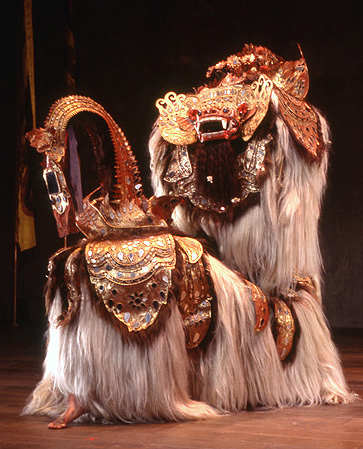Faculty’s Mythical Creature Part of Museum Exhibit
| Posted 09/19/07 |
 For the past three years, Ron Jenkins has shared his office with a 10-foot-long Balinese dragon. But recently, his fire-breathing friend has found a temporary home inside the American Museum of Natural History in New York City. For the past three years, Ron Jenkins has shared his office with a 10-foot-long Balinese dragon. But recently, his fire-breathing friend has found a temporary home inside the American Museum of Natural History in New York City.
The professor of theater, who uses the dragon as a teaching tool on Balinese theater, lent his mythological model, pictured at right, to the museum last May. The dragon is part of an exhibit titled Mythic Creatures: Dragons, Unicorns & Mermaids, which is on exhibit in New York through January 6, 2008. The dragon is a mythical creature that embodies the positive protective spirits of the universe, according to the Balinese Hindu cosmology, Jenkins explains. Wesleyan alumni and students should all bring their families to visit the dragon at the museum. Its down the hall from the dinosaurs and just next to a unicorn and a kraken. Jenkins, an expert on Balinese performance traditions, has been conducting research in Bali for 30 years. He acquired the dragon from a village artisan in Singapadu, Bali, where it is called a barong. The barong is performed in sacred temple ceremonies that depict the struggle between good and evil. The dragon fights for good against the witch, who is known as a calonarang. The battle often culminates in trances during which villagers stab themselves with sacred wavy knives. Wesleyan students have had the opportunity to dance inside the barong during the 2005 production of Shakespeare’s “Tempest” at the Center for the Arts. The play was set on the island of Bali and incorporated Gamelan musicians from the Indonesian Consulate in New York. So far, none of my students have gone into trance, Jenkins jokes. Jenkins creature is brought to life by having two dancers get inside the shaggy fur body. One controls the clacking of the red masks movable jaws. The other works the tail, which is ornamented with bells and mirrors. The dancers feet are visible under the body, an effect similar to watching a stage animal in a Vaudeville routine, Jenkins explains. Jenkins was pleased to loan the dragon to the American Museum of Natural History for the exhibit. From January to August 2007, Jenkins spent his spring sabbatical as a Fulbright scholar in Bali working on a project titled, Messages of Tolerance in Hindu Temple Ceremonies. I felt badly about the prospect of leaving the barong alone in my office while I was in Bali visiting other barongs, Jenkins says. It seemed almost like I was being unfaithful, so I was happy to find him a temporary home where he could enjoy the company of other mythological creatures. But now that Im back, my office seems so empty without him. During his fellowship in Bali, Jenkins worked with Nyoman Catra, who received his Ph.D. in ethnomusicology from Wesleyan in 2005. Together, they translated texts of sacred performances, some of which involved a barong. Their book of translations will be published next year as the first in a series of books to emerge from an international translation center Jenkins directs at the Indonesian National University in Denpasar, Bali. Admission to Mystic Creatures is available by ticketed timed entry only. More information on the exhibit is online at http://www.amnh.org/exhibitions/mythiccreatures/, and ticketing ordering information is online at http://www.amnh.org/exhibitions/mythiccreatures/visitor_info.php# |
| By Olivia Drake, Wesleyan Connection editor. Photo contributed. |

